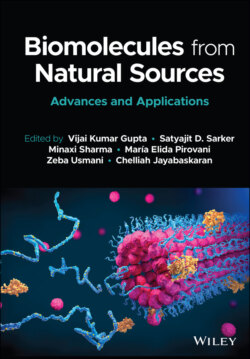Читать книгу Biomolecules from Natural Sources - Группа авторов - Страница 85
2.9 Biopolymer Type Number 8: Polythioesters
ОглавлениеIn 2001, Lütke-Eversloh et al. published the first report on microbial polythioesters (PTEs). PTEs were synthesized by the same polymerase which synthesizes PHAs make PTEs unique biopolymers [220, 221, 300]. The first examples of PTEs were copolymers containing 3HB and 3-mercaptopropionate (3MP), which were obtained from the PHA accumulating bacterium Ralstonia eutropha strain H16 – a “model organism” in PHA research. Adding different precursor substrates is a tool for accelerating the polymerization process or for incorporating another monomric forma of PMAs. Polythioester production also includes incorporating monomeric formes of 3-hydroxybutyrate and 3-mercaptobutyrate, poly(3HB-co-3MB). The total polymer yield by R. eutropha, when 3-mercaptobutyric acid was fed as a carbon source in addition to gluconate contributed to up to 31% of the cellular dry weight. Mutants of R. eutropha with defective PHA synthase were not able to synthesize these copolymers. This demonstrated that the PHA synthase is responsible for the incorporation of 3MP and generally for biosynthesis of PTEs. If R. eutropha was cultivated in the presence of either 3-mercaptopropionic acid, 3,3’ -thiodipropionic acid (TDP) or 3,3’ -dithiodipropionic acid (DTDP), the copolymer poly- (3HB-co-3MP) was accumulated comprising molar fractions of 3MP of up to 54 mol-%. None of the sulfur-containing precursor substrates was utilized as sole carbon source for growth, thus, a second carbon source such as sodium gluconate was provided additionally to enable bacterial growth. The copolymer composition and polymer content referring to the cellular dry weight could be influenced by varying cultivation conditions and feeding regimes. When carbon sources, which are metabolized to acetyl coenzymeA(acetyl-CoA) were present in the culture medium of R. eutropha, the molar ratios of 3MP were usually less than 5 mol-%. It was observed that the total polymer yield decreased simultaneously to increasing 3MP content. However, this is not a strict rule, because other factors like the duration of fermentation also influenced the molecular weights of the accumulated polymers. 3-mercaptovalerate (3MV) were identified as constituents of PTE copolymers isolated from R. eutropha, extending the group of PTE constituents, which were referred to as 3-mercaptoalkanoates (3MA) [220, 221, 300].
